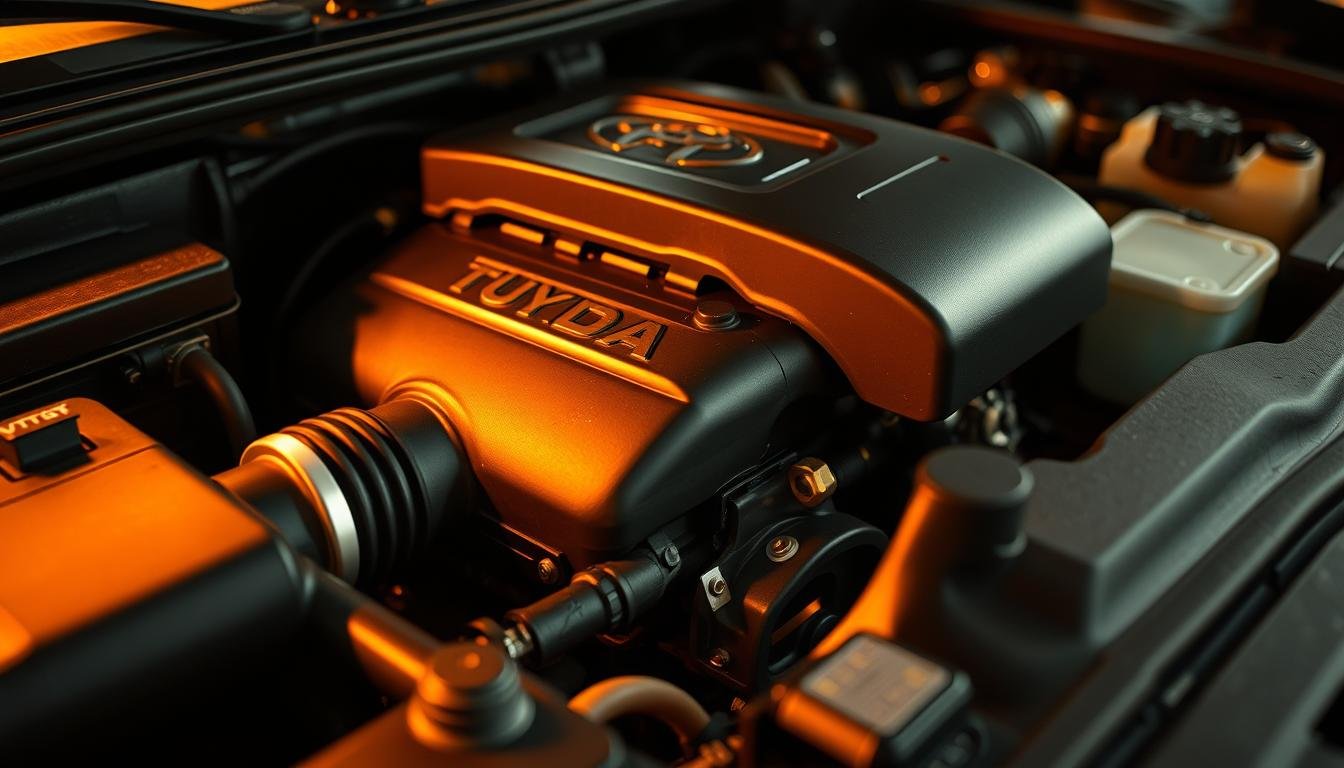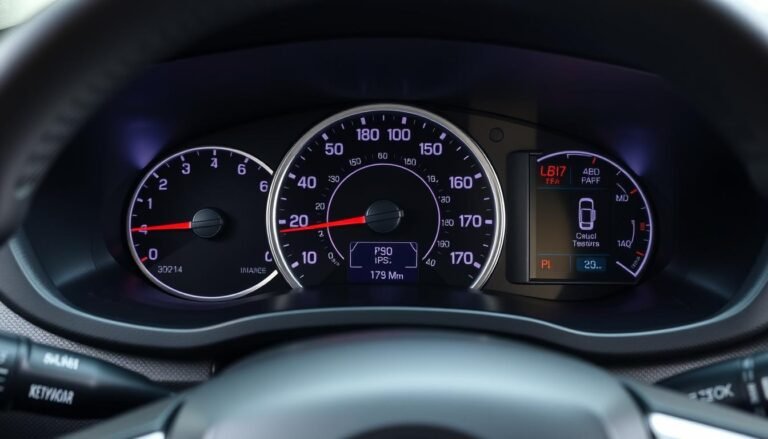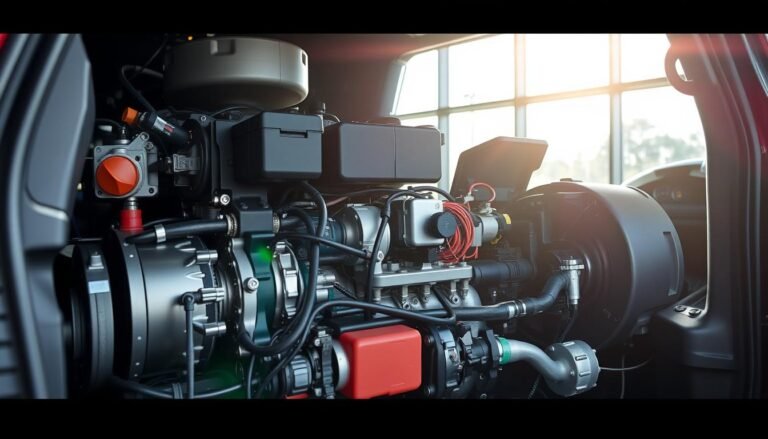Toyota Tundra Engine Problems: Overview & Tips
Many Toyota Tundra truck owners are concerned about engine problems. This comes after a big recall of over 100,000 models.
The recall was due to engine failures linked to the new V35A twin-turbo V6 engine. Knowing the common issues can help you spot and fix problems early, keeping your truck dependable.
We’ll look at the main signs of engine troubles and how they affect your truck. We’ll also cover steps to troubleshoot these issues effectively.
Plus, you’ll learn about what causes these failures and tips to keep your engine running longer.
By being proactive, you can avoid costly repairs and extend the life of your Toyota Tundra. We’re going to dive deep into the specifics of Toyota Tundra engine troubles.
You’ll learn vital tips on handling engine problems confidently. Are you ready to keep your Tundra in excellent condition? Let’s begin!
Introduction To Toyota Tundra Engines
The Toyota Tundra has really changed, especially its engines. They moved from old V8 engines to new twin-turbo V6 engines.
This change makes the truck more powerful and fuel-efficient, keeping the Tundra’s strong reputation. Looking at the new V35A engines show they’re pretty impressive.
They offer power from 348 to 389 horsepower. This puts them at the top in the pickup truck world.
The twin-turbo V6 engine shows Toyota’s effort to be more eco-friendly without losing any power. People really like this new engine because it’s powerful and efficient.
These upgrades mean the Tundra is getting ready for the future. It will have cleaner emissions and better fuel economy but remain as strong as ever.
Knowing about the different Tundra engines helps you pick the one that’s right for you.
What is Common Issues with Toyota Tundra Engine?
Checking your Toyota Tundra’s engine for problems is key to keeping it running well. It’s important to know the early signs of toyota tundra engine troubles to prevent bigger issues later.
Learn the main signals that show your engine needs a check-up.
Typical Symptoms of Engine Problems
There are a few signs that might point to engine issues. Look out for:
- Knocking or pinging sounds during acceleration
- Frequent stalling or difficulty starting
- Rough idle or inconsistencies in engine behavior
- A lot of exhaust smoke or strange smells
- The appearance of dashboard warnings, like the check engine light
Noticing these signs early means you can address engine problems quickly. This prevents further damage.
Impact of Engine Issues on Performance
Engine problems can greatly affect your truck’s performance. For instance, you might notice poor acceleration from engine misfires.
Fuel efficiency can also go down due to fuel delivery issues. Bad engine performance is not just inconvenient; it can also be unsafe, making it hard to brake or merge into traffic safely.
Getting engine problems fixed early means your ride stays smooth. This also keeps your car in good shape for longer.
Toyota Tundra Engine Problems: Overview
The Toyota Tundra has met with engine reliability concerns that dulled its image among truck enthusiasts.
The toyota tundra engine problems summary pinpoints issues originating from its design and manufacture, notably with the V35A engine type.
Dirty production practices led to critical failures in the main bearing, causing engines to stall while on the move.
Owners of the Toyota Tundra often talk about hearing odd knocking noises, seeing a drop in power, or noticing warning indicators lighting up the dashboard.
Such issues question the engine’s capability and the truck’s overall dependability and safety.
Toyota has recognized these flaws and is actively working to gain back customer confidence in this key model.
Transmission Issues Affecting The Toyota Tundra
Transmission issues can really slow down your Toyota Tundra. Owners may notice signs that point to trouble.
Recognizing these signs early can help fix the problem sooner. Here, we’ll talk about the common signs of transmission failure and how to solve them.
Signs of Transmission Problems
- Delayed shifting between gears
- Unusual noises like grinding or whining
- Overheating during use
- Fluid leaks under the vehicle
- Dashboard warning lights for transmission issues
Recommended Solutions and Repairs
To fix Toyota Tundra transmission problems, a step-by-step plan is best. Keeping up with regular maintenance is key to avoiding big problems.
Below are some strategies to help fix transmission issues:
- Change fluids regularly to keep things running smoothly.
- Check the transmission for leaks or wear often.
- If problems pop up, see a pro to check if you need new fluid, gasket changes, or a total system fix.
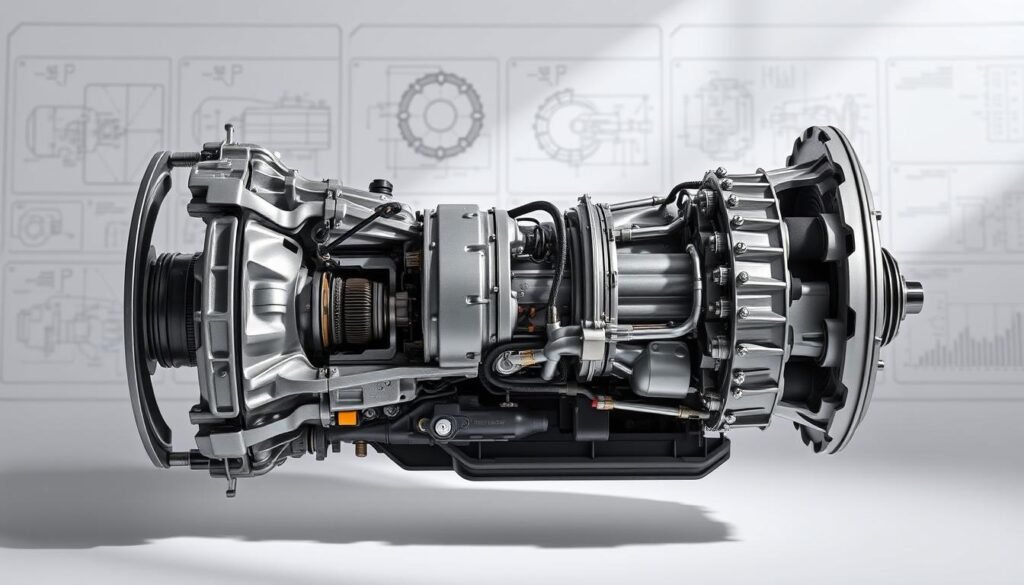
Staying on top of maintenance can lower the chance of transmission problems. This way, your Toyota Tundra will run smoothly.
Frame Rust and Corrosion: Impact on Engine Health
Frame rust and corrosion can seriously affect your Toyota Tundra. It harms not just the vehicle’s structure but also the engine’s health.
It’s vital to identify frame corrosion early. This helps keep your car running well and avoids expensive fixes.
Identification and Prevention Techniques
Regular checks are key to managing Toyota Tundra frame rust. Start by examining the underside of your vehicle for rust signs.
Pay special attention to areas like:
- Undercarriage: Check for flaking paint or bare metal showing signs of oxidation.
- Weld seams: Inspect weld spots where corrosion can accumulate.
- Suspension components: Look for rust on parts that come in contact with road debris.
Learn the different rust patterns for better identification. Common types include:
- Pitting: Small indentations in the metal caused by moisture exposure.
- Surface rust: A light brown discoloration that indicates early corrosion.
- Scaling: Layers of rust forming that can eventually flake off.
To prevent rust, consider these strategies:
- Protective coatings: Apply rust-inhibiting paint or sealants to vulnerable areas.
- Regular cleaning: Keep the undercarriage clean from debris and moisture, especially during winter months.
- Professional inspections: Schedule routine checks by a qualified mechanic to ensure any rust issues are promptly addressed.
Troubleshooting Toyota Tundra Engine Problems
Troubleshooting your Toyota Tundra engine problems promptly can save time and money.
This engine trouble guide helps you identify common engine issues by focusing on specific symptoms.
Compromise these indications allows for quicker diagnosis and effective resolutions. First, perform a visual inspection of the engine bay.
Look for any signs of leakage, damaged belts, or disconnected hoses. These preliminary checks often reveal critical issues that require immediate attention.
Next, pay attention to audio cues. Unusual sounds such as knocking or grinding can indicate serious problems within the engine.
These noises should not be ignored as they often precede more significant failures.
Utilizing a diagnostic tool to read error codes is essential when troubleshooting the Toyota Tundra engine.
The codes provide insight into what’s wrong, guiding you toward resolving engine issues. Follow these steps for effective troubleshooting:
- Conduct a visual inspection of the engine.
- Listen for abnormal sounds during operation.
- Connect a diagnostic scanner to retrieve error codes.
- Refer to the owner’s manual for code meanings.
- Address any specific issues indicated by the error codes.
Implementing this structured approach allows you to diagnose potential issues skillfully.
By focusing on symptoms and using available tools, you enhance your capability in troubleshooting Toyota Tundra engine problems.
Toyota Tundra Engine Codes: What To Look For
Learning engine codes is key to finding out what’s wrong with your Toyota Tundra. By interpreting Toyota Tundra engine diagnostic codes, you can spot specific issues early.
These codes are signals from your vehicle’s computer about your engine’s health. To get these codes, you’ll need an OBD-II scanner.
This device connects to your vehicle’s system to read the codes. The scanner shows the diagnostic trouble codes (DTCs).
Each code tells you about a different problem, helping you find what needs fixing.
Below is a table showcasing some common Toyota Tundra engine diagnostic codes and their meanings:
| Code | Description |
|---|---|
| P0301 | Cylinder 1 Misfire Detected |
| P0420 | Catalytic Converter Efficiency Below Threshold (Bank 1) |
| P0171 | System Too Lean (Bank 1) |
| P0131 | O2 Sensor Circuit Low Voltage (Bank 1, Sensor 1) |
| P0441 | Evaporative Emission Control System Incorrect Purge Flow |
When you see these engine trouble codes, you’ll know how to start fixing the problems.
Knowing about engine codes lets you take good care of your vehicle. It can also prevent further issues.
How To Diagnose Toyota Tundra Engine Problems?
Diagnosing Toyota Tundra engine issues requires the right diagnostic tools and knowledge. These tools help you find and fix problems effectively.
As a vehicle owner, this knowledge gives you the confidence to make smart maintenance decisions.
Diagnostic Tools and Techniques
There are several tools for diagnosing engine problems in your Toyota Tundra. Each has a specific purpose. It’s important to know how to use them for correct problem analysis.
- OBD-II Scanners: These scanners read trouble codes from your vehicle’s engine control unit by connecting to the diagnostics port. They efficiently pinpoint engine issues.
- Multimeters: A multimeter measures voltage, current, and resistance in electrical circuits. This is useful for finding electrical issues that might impact engine performance.
- Compression Testers: This tool checks the pressure in each cylinder. It helps find problems with piston rings or valves that are key for engine health.
- Fuel Pressure Gauges: These check the fuel system’s pressure against the manufacturer’s specs. Low pressure can cause big engine problems.
Below is a table showing each diagnostic tool, what it does, and how it’s used for engine analysis:
| Diagnostic Tool | Function | Engine Analysis Technique |
|---|---|---|
| OBD-II Scanner | Reads and clears trouble codes | Code interpretation and troubleshooting |
| Multimeter | Measures electrical parameters | Identifying faulty sensors and circuits |
| Compression Tester | Measures cylinder pressure | Assessing internal engine integrity |
| Fuel Pressure Gauge | Checks fuel system pressure | Evaluating fuel delivery performance |
Using these tools simplifies diagnosing engine problems in a Toyota Tundra. Knowing the related techniques allows you to interpret data well. This leads to better maintenance and repair.
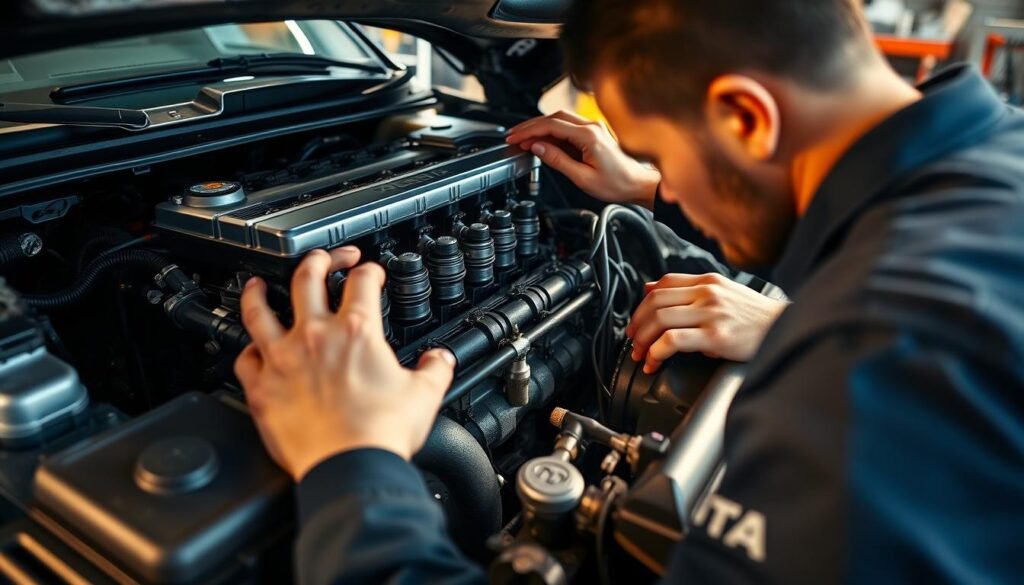
Common Causes of Toyota Tundra Engine Failure
It’s important to know why Toyota Tundra engines fail to keep your vehicle reliable. Various factors cause engine problems, affecting how well it works and lasts.
By learning about these troubles, you can take steps to keep your engine running well. This part focuses on the main reasons Toyota Tundra engines, especially the V35A, have issues.
Key Factors Leading To Engine Troubles
Toyota Tundra engine failures often come from manufacturing mistakes, design issues, and skipping maintenance. Here are the main reasons:
- Manufacturing Defects: Some engines have flaws from the factory that hurt their performance.
- Improper Maintenance: Not changing the oil or doing other regular upkeep can cause a lot of damage, leading to engine problems.
- Design Flaws: Some design choices, especially with the V35A engine, can make reliability worse as time goes on.
These factors together show why some Toyota Tundras have reliability problems. Each part affects how long your truck will last.
By understanding these issues, you can take better care of your truck for a smoother ride.
| Cause of Engine Failure | Description | Impact on Reliability |
|---|---|---|
| Manufacturing Defects | Poor quality control leading to flawed components. | Reduced engine lifespan and performance degradation. |
| Improper Maintenance | Failure to adhere to maintenance schedules. | Increased wear, leading to potential engine breakdowns. |
| Design Flaws | Inherent issues within engine design, particularly evident in V35A. | Persistent reliability issues contributing to engine failure. |
Resolving Toyota Tundra Engine Issues
Fixing your Toyota Tundra’s engine issues starts with a clear plan. This guide lays out the basic steps. It covers both small and big fixes. By following these steps, you might save some cash.
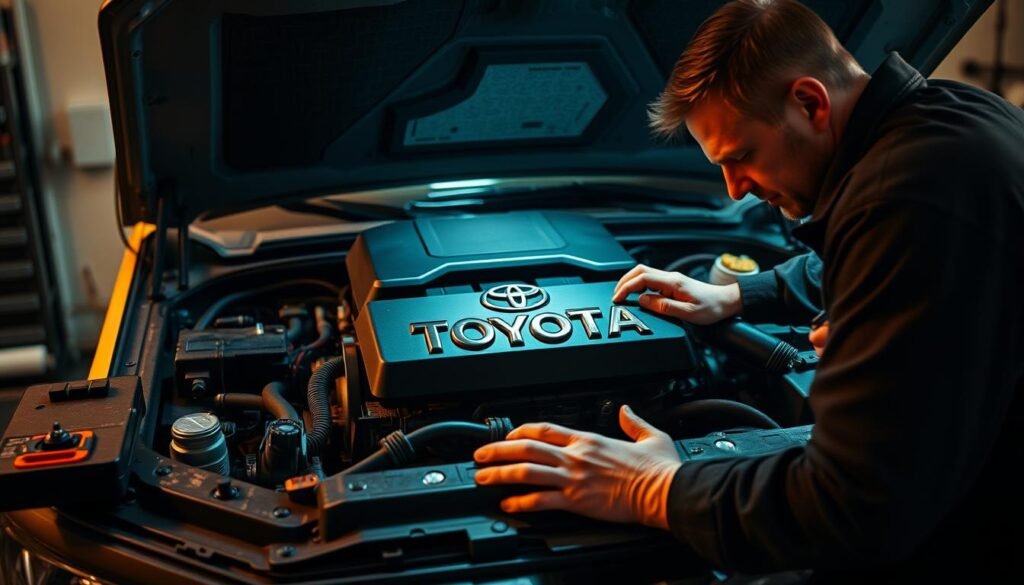
Step-by-Step Repair Guide
First, let’s get ready to fix engine problems. Here’s what to do step by step:
- Identify the Issue: Start by figuring out what’s wrong. Use a code reader for accurate diagnosis.
- Gather Required Tools: Collect necessary tools like wrenches and screwdrivers, plus any parts you need to replace.
- Check Engine Oil: Look at the oil level. Add more or change it if it’s low to prevent damage.
- Inspect Spark Plugs: Take out and check spark plugs. Get new ones if they’re worn out to boost performance.
- Evaluate Fuel System: Look for blockages or leaks in fuel lines and filters. Clean or replace them as needed.
- Test Battery and Electrical Connections: Make sure the battery is good. Clean connections and swap out any bad cables.
- Consult Professional Help: If problems are still there, it’s wise to get help from an expert to avoid making it worse.
By following these steps, fixing engine issues can be straightforward. This guide helps you deal with many common truck problems. With the right methods, you can keep your Toyota Tundra’s engine in top shape.
Toyota Tundra Engine Maintenance Tips
To keep your Toyota Tundra’s engine running well, regular checks are key. By following a structured maintenance plan, your car will be more reliable and perform better.
Here, you’ll find what you need to do regularly to take good care of your engine.
Regular Maintenance Checklist
| Maintenance Task | Frequency | Details |
|---|---|---|
| Oil Change | Every 5,000 miles | Replace oil and oil filter to ensure efficient engine lubrication. |
| Air Filter Replacement | Every 15,000 miles | Check and replace dirty air filters to improve air intake and engine performance. |
| Fluid Level Checks | Monthly | Inspect engine oil, coolant, and transmission fluid levels. Top up as necessary. |
| Brake Inspection | Every 10,000 miles | Examine brake pads and rotors for wear to prevent safety issues. |
| Tire Rotation | Every 5,000 miles | Rotate tires to achieve even wear and extend their lifespan. |
Importance of Preventative Care
Taking preventative steps reduces the chance of big repairs later. Regular checks help find small problems early.
This way, maintaining your Toyota Tundra’s engine enhances its performance and saves money by improving gas mileage.
Recalls and Manufacturer Response
Recent recalls of the Toyota Tundra, especially the 2022 and 2023 models, worry owners.
Problems with the engine that might affect the vehicle’s performance and safety are the main concern.
Knowing about these recalls helps owners keep their vehicles safe and dependable.
Notable Recalls Related To Engine Problems
Major recalls for the Toyota Tundra focus on potential engine issues. These could cause the car to stall or lose power.
Specific recalls aim to replace faulty engine parts to improve safety and reliability. Owners affected are being informed and solutions are being provided quickly.
What Toyota is Doing To Address Issues?
Toyota is acting to rebuild trust with their customers in light of these issues. They are keeping customers informed and offering free services.
The company is making sure that problems with the engine are fixed at service centers. They are committed to repairing and servicing to keep the vehicles running well.
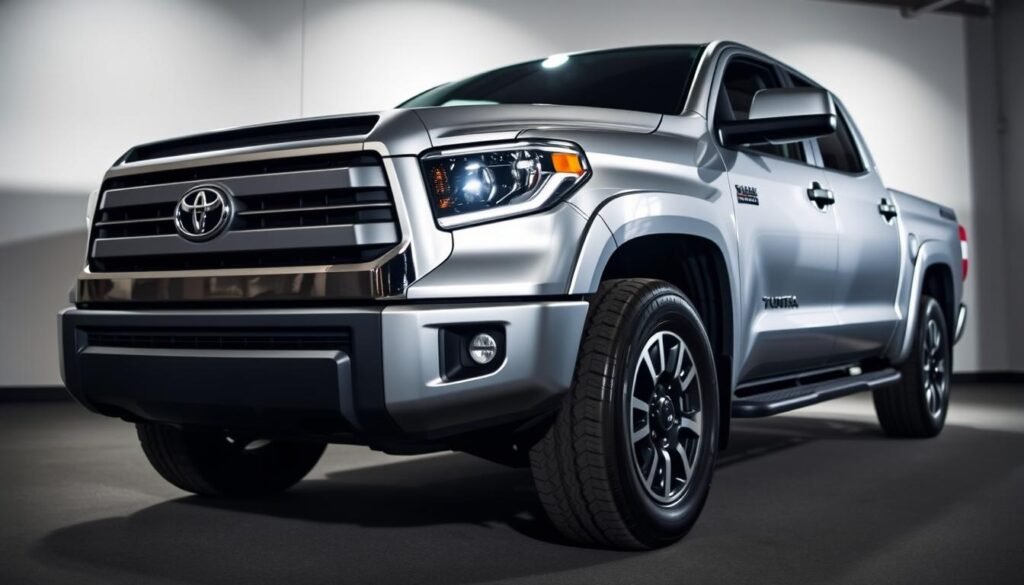
Conclusion
Summing up the problems with Toyota Tundra engines, we’ve looked at various issues. These can impact how well the truck works and its dependability.
Problems like gear issues and frame rust matter a lot. Knowing these concerns helps you act early to avoid big repair costs.
The final word on the Tundra’s reliability highlights its strong points. Yet, being observant is key.
Keeping up with recall news, engine care, and regular inspections protects your truck. Doing this, you’re better prepared for any engine trouble that may come up.
This recap on Toyota engine problems emphasizes staying alert and doing regular maintenance.
Making smart decisions and using resources wisely boosts your Tundra’s lifespan. It also helps ensure you enjoy a hassle-free ride.
FAQs
What are common symptoms of engine problems in the Toyota Tundra?
Common symptoms include knocking sounds, stalling, rough running, poor acceleration, and decreased fuel efficiency.
How can I diagnose Toyota Tundra engine problems effectively?
To diagnose engine problems, start with visual inspections and listen for unusual noises. Use OBD-II scanners to check for specific diagnostic codes.
What are the main causes of engine failure in the Toyota Tundra?
Main causes include manufacturing mistakes, like contamination, improper maintenance, and design issues with the V35A engine.
How do I interpret Toyota Tundra engine codes?
Use an OBD-II scanner to read engine codes. Each code points to a specific problem, helping you fix it right.
What steps should I follow to resolve engine issues in my Toyota Tundra?
Begin by identifying symptoms. Then, use diagnostic tools to read codes. Follow a guide for repairs, including part changes and tweaks.
What preventive maintenance tips can help avoid Toyota Tundra engine problems?
For maintenance, make sure to change the oil on time, replace the air filter regularly, and check fluids. Doing this helps your engine run better and last longer.
Are there specific recalls related to Toyota Tundra engine issues?
Yes, there have been important recalls, especially for 2022 and 2023 models. These focus on fixing V35A engine problems. Toyota provides engine replacements and customer support.
How can I identify rust and corrosion that affects my Toyota Tundra engine?
Check the undercarriage for rust and look for wet spots and debris that cause rust. Regular checks help you keep damage under control.

